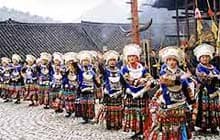This article by Imperial Tours’ founder about the tribes of Guizhou is for cultural informational purposes only. Imperial Tours does not offer services to these destinations as luxury faciltiies are not available.
By Guy Rubin
As cranes and bulldozers proliferate like ants across China, depositing cities and highways in their hammering trail, now is the time to venture inland in search of the more traditional side of China. » Read more »
» Read more »As you stroll through the caves in Guangxi province, you might ponder on their formation and try to spot some of their intriguing features.
Formation
The life-span of a solution cave can be split into three phases:
(i) Initiation phase: groundwater seeps slowly through cracks and fractures in the limestone bedding planes. Over 3,000 to 10,000 years are needed to turn one such fracture to a pencil-sized opening of 5 to 10 mm wide. » Read more »
» Read more »"They were the oddest hills in the world, and the most Chinese, because these are the hills that are depicted in every Chinese scroll. It is almost a sacred landscape – it is certainly an emblematic one."
Paul Theroux, Riding the Iron Rooster, 1988
When looking at a Chinese painting, most visitors will remark upon the enormous differences from Western painting tradition. Foremost among the differences are the use of ink and silk paper as opposed to oil and canvas, » Read more »
» Read more »Day One
Arrive at the Hotel of Modern Art and enjoy a relaxing meal or a stroll through the tiny, pedestrian streets of Yangshuo village. (Hotel of Modern Art – Deluxe Room) (D)
Day Two
In the morning we will take a relaxing boat-ride along a rarely visited stretch of the Li River: fishermen use cormorants to fish, clumbs of bamboo trees line the shores, » Read more »
» Read more »The Nan mountains, dividing the Yangzi river basin to the north from the Xi river valley to the south, have always protected Guangxi province from unwelcome intruders. They not only shelter this tropical region from the cruelly bitter winds of the Gobi, throughout its history they’ve also shielded it from the encroachments of the Imperialist Han Empire.
From their first invasion here in the 3rd century BC until the 12th century AD, the Han Chinese considered Guangxi an exotic region inhabited by barbaric and unruly aboriginal tribes. » Read more »
» Read more »


